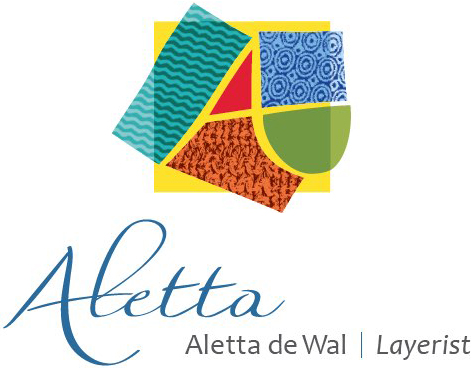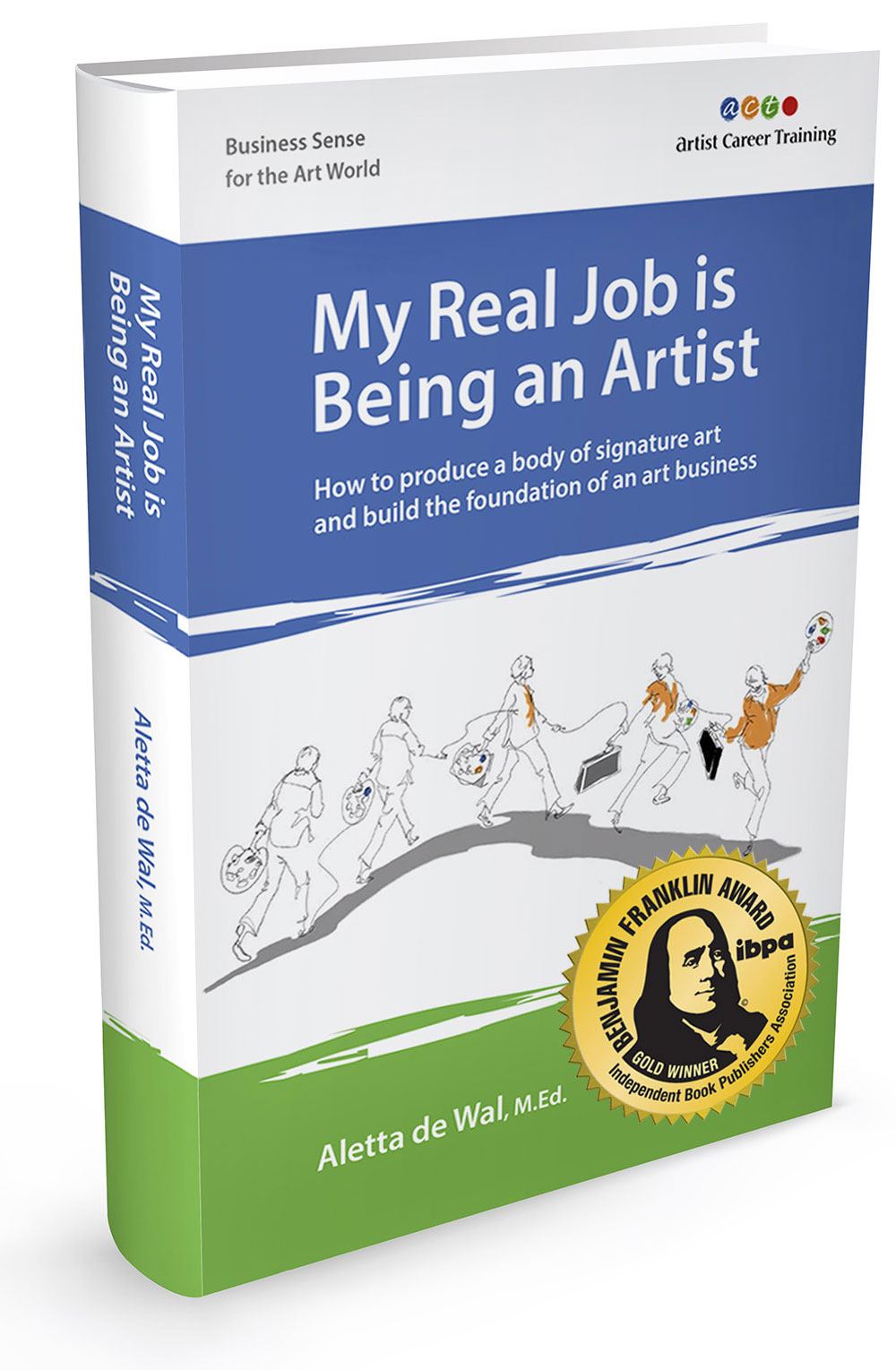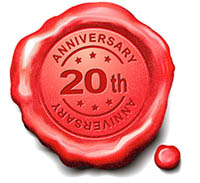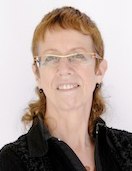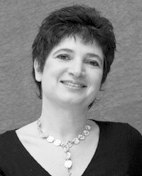Margot Knight, Champion of Artists at The Djerassi Resident Artists Program
There is often additional information on the recording that is not in this written interview. Inspire yourself and listen while you make art.
My primary goal in these interviews is to inspire you with stories of people who make a living helping artists make a living making art and who consider it a real job. The art professionals I interview here have valuable tales to tell you about how to work with them.
 Margot Knight, Executive Director, The Djerassi Resident Artists Program Photo © William CouponMargot Knight served as President and CEO of United Arts of Central Florida from 2001 until she recently succeeded Dennis O'Leary as Executive Director of The Djerassi Resident Artists Program (DRAP).
Margot Knight, Executive Director, The Djerassi Resident Artists Program Photo © William CouponMargot Knight served as President and CEO of United Arts of Central Florida from 2001 until she recently succeeded Dennis O'Leary as Executive Director of The Djerassi Resident Artists Program (DRAP).
In Margot's own words, "I have spent my adult life supporting artists and the organizations that showcase and employ them. The opportunity to build on Dennis's leadership and advance the Djerassi Program's critical mission to provide space and time for artists from around the world is a once-in-a-lifetime opportunity."
A.C.T. Read this recent blog post by Margot to be clear that we agree on "No More 'Starving Artists'":
There is a provocative piece on the Americans for the Arts Linked-In blog by the abundant artist. Site blogger Jarvis posits that the proverbial "starving artist" is a self-defeating mind-set and he offers his antidotes. I personally abhor that term. It should be stricken from the lexicon along with some other phrases that are derogatory and demeaning towards art and artists. "Fine" art is one expression. And let's banish forever "artsy fartsy." Artists are entrepreneurs. Artists are innovators. Artists are brave and take more risks in a day than many of us take in a lifetime.
To my mind, artists are small businesses - "doing the work no one knew needed to be done," as poet Alberto Rios puts it. Artists matter. The artistic PROCESS matters. We should strive for a society that reveres rather than scorns artists.
Are artists often misunderstood? You bet. It is not an easy path. And artists often paint themselves as outsiders, which contributes to the hallucination too many people have about them.
Artists are essential members of society - this has been the case throughout history. It is our privilege to say YES to artists. As DRAP board member Lava Thomas says, "Creativity reigns supreme at Djerassi." Amen.
A.C.T.: What prompted you to start your professional art career? What makes an artist professional?
I grew up in a household that had one foot in the military and one foot in art. My father played about fifteen instruments and I grew up singing blue grass before I was three. He was also a practical guy and wasn't really thrilled when I talked about majoring in theater, so instead I majored in social science studies and Russian.
I wanted to be a high school history teacher but when I looked for work, discovered I had overlooked a key skill of almost all history, political science and geography teachers. I had forgotten to learn how to coach football. So, I did the reverse of what many people do - I fell back on my acting, moved to New York and worked for a couple of years as an actor and dancer. I discovered I had just enough talent to make me miserable and that everybody in New York had been the lead in college plays. Basically, I didn't trust my own talent, have the ego or intestinal fortitude to be an actor. I got tired of waiting for other people to give me work.
So, after a stint as an oral history interviewer with the Comprehensive Employment Training program (CETA), I started writing grants to produce theater productions and radio shows about the history of the people I had interviewed. I wrote some plays based on oral histories and shifted over to arts, as an advocate rather than a commercial agent for artists. Each of my seven jobs in the last thirty-four years has combined my love for history, art and writing (and being bossy). I'm very good with promoting what I believe and I am organized, so that became my niche.
I have my own practice as a writer and essayist. I'm sketching out something about "Adventures with Artists" about my experiences here.
A.C.T.: What is the mission of The Djerassi Resident Artists Program? Please tell us about the journey from founding until now.
We have a dual mission to provide uninterrupted time to artists and to protect the property upon which DRAP is situated. Only 1000 people per year are granted access.
Recognized as one of the world's most prestigious artist residencies, the Djerassi Program has accelerated the creative process of more than 2100 artists since being founded in 1979 and is recognized as one of the largest programs of its kind in the west. We serve visual artists, dancers, composers and writers. Only 14% of U.S. residencies have a fully sprung dance floor - and we have amazing views. We also have a full composer's studio.
Our history is deeply tied to art, land, family loss and celebration.
In 1978, a young artist and poet, Pamela Djerassi committed suicide. Her father, renowned chemist Carl Djerassi and partner (later wife) Diane Middlebrook, were on a visit to Florence. While sitting in the piazza looking at the art that resulted from the investment of the de Mediccis, they wondered what might have happened if women artists had been supported as much as the men. When they returned, they set out to honor Pamela's memory by creating a nurturing environment for living artists. Dr. Djerassi's working cattle ranch in the Santa Cruz mountains, along with Pamela's home and land were transformed. For the first few years women artists identified in collaboration with Stanford's Center for Research on Women, that Diane Middlebrook was instrumental in creating, came to Djerassi. Cancer claimed Diane's life in 2007. Again, Dr. Djerassi determined that supporting artists was a fitting memorial. The Middlebrook Studios, four cabins for writers, are a poignant testament to the creative cycle of love and loss. Dale Djerassi - Dr. Djerassi's son and Pamela's brother - continues the legacy as a founding member on the Board of Trustees. Djerassi Program Artists Barn as a working cattle ranch
Djerassi Program Artists Barn as a working cattle ranch
A.C.T.: Tell us about your team, how they qualified to work with you.
We have a staff of nine, including myself. Several are practicing artists. We are CPR trained, and three of us live on site because our location is remote, and we have to make sure everything runs 24/7. Only two of us are full-time. Each position has its own requirements for knowledge, skills and abilities. Since I am new, I inherited this staff. BUT, in twenty-two years of hiring I look for adventurous spirits with good attitudes. I look for clarity in thinking, writing and speaking. And I look for resilient, reliable people who understand the flexibility required to work in a non-profit arts organization.
A.C.T.: Who do you work with, how do artists apply and how do they benefit from your residencies?
Over our thirty-three years resident artists have hailed from forty-six U.S. states and forty-seven countries. Austrian born founder Carl Djerassi is now an active scientific lecturer and playwright who believes in science and theater. He has an international reputation in science that attracts wide interest. In November 2013, we will have a special call for artists who have an interest in science and scientists who have an interest in art to work together.
Each artist is provided, at no charge, work and living space, meals, and local transportation. (It costs about $10,000 per artist per month.) We have capacity for twelve artists and we get a new group each month. Collegiality amongst artists from various disciplines, including visual artists, is a part of the experience that contributes to a generosity of artistic spirit. Unexpected serendipitous relationships have sprung from the mix, like a trumpet player who created original music for a dance troupe. A performance artist and scientist worked together on a one-man show about astronomer Johannes Kepler. We've had friendships and marriages and a group who created a private Facebook page for the members to stay in touch.
A select number of artists are invited based on the quality and direction of their work. The process is competitive-ten artists apply for every spot available. This year we had 565 applicants for sixty-five spots. With a February 15th deadline for residencies for the following year, we have time for rigorous review by juries of prestigious peers in each art form.
I tell resident artists that they have come to a place where they can just "BE." Our cell phone and Internet reception is sketchy and I encourage artist to come without a car to minimize distractions.
Our second largest group is from New York. Some of them are unfamiliar with the wildlife we have on the property and some had never seen a rabbit and sometimes can't sleep because it's so quiet.
A.C.T.: Does the artist's career stage matter for them to benefit? What kinds of issues do they seem to wrestle with most?
We have emerging, mid-career and established artists apply for residencies. Artists in the earlier stages of their career often need time away from day jobs. Artists farther along may come for a change of scene to find a new place to be in their art.
Sometimes artists need to escape in order to engage with the community. The benefit artists derive is up to them. There are no work requirements, although they are amazingly productive while they are here.
I can't typify their struggles except to say that some clearly struggle more than others. Balancing work and personal obligations, over-committing and still feeling like they're not doing enough are frequent things I've heard.
A.C.T.: What is your business model? How do you fund the program?
Barely and with difficulty. In this economy, it's hard to make the case that an artist spending time alone on a mountain top makes the world a better place.
Carl Djerassi donated the land and provides some capital but is no longer involved in the operations. Since 1994, we have been an independent 501 c (3) entity, relying on the generosity of individual, foundation and government donors. To fulfill our dual mission, we allied in 1998 with the Peninsula Open Space Trust to create a conservation easement to ensure the property's protection in perpetuity.
 "Yield To Whim", 1983, by Frank Foreman
"Yield To Whim", 1983, by Frank Foreman
I get discouraged when I meet people who say "The private sector should pay for this." There's not a thriving cultural society that has ever lived by that. It's always a partnership with Kings and Queens or with government. Artists designed your carpet, decided what color your car is - art surrounds us all the time. Trying to remind people of the role that artists play in their lives is something I am conscious of every single day.
One of my other hobby horses is that our board members need to wear their arts hats too. While I do The Chamber of Commerce, our board members are more often in a place where their beliefs about artists can make a true difference - more than I can. Peers listen to peers.
We have a mix of earned income, foundation support and support from individuals along with one source of government funding - the National Endowment for the Arts, for which we always rank near the top. We've had support from the Irvine and Hewlett Foundations and a few others for the last several years; and about 100 individual donors. We have an endowment from donations made twenty years ago to support some artists and are looking for an endowed fellowship in the next couple of years. We have some income earning opportunities as well, like a writers' workshop with a well-known writer, when artists are not in residence. We are expanding our sculpture walks and offering corporate retreats. We are also exploring partnerships with organizations, like the San Francisco Film Society, that are already dedicated to artistic development.
A.C.T.: Please describe a typical day, and a typical month so readers can understand how you manage your time, money and energy.
I always say that 25% of your day is out of your control. Once you align yourself with that reality, you don't get so stressed out. When you manage facilities that are fifty years old, you never know what toll entropy might take. We had a tree fall across our only road and had to wait for the fire department to take it out. We have our own micro-climate so the weather is also unpredictable.
One thing about living on a remote wilderness is that no day is typical. Today I'm dealing with exterminators to solve a problem endemic to living in the middle of the mountains - pests. Then I'll have a staff meeting to review all the plans for our open house. Yesterday I took a group of foundation executives on a sculpture hike and later had to check myself for ticks. I facilitated a group of artists to create topics and formats for our lecture series. I signed thank you letters to donors. I proofed the final version of our new program brochure. And I am doing this interview with you.
We elected five new board members last week so there will be orientation packages and discussions with them.
Every month I welcome the new group of eight to ten artists and eat dinner with them twice a week. I set up meetings with donors. I write and review foundation proposals. I update our Face Book and twitter accounts regularly.
A.C.T.: What peak moments have you and the team had throughout the programs?
I'm "required" to eat with the artists twice a week and I keep up with and share what other artists have done after they leave.
I embrace reading the evaluations from artists each month. They say things that you hope will happen, but you can't make happen. One of our artists from Mongolia just won a Fulbright to work in New York for two years.
Thank-you notes from artists mean a lot, as is hearing about new work that was created here. There is a deep satisfaction in knowing that we are contributing directly to the vibrancy of the universe by providing a safe place for artists to pursue their passions.
A.C.T.: How do you define success and how do you celebrate it?
Success is always best defined by a shared sense of accomplishment. We celebrate by laughing and thanking each other for jobs well done.
 Guests enjoying the Djerassi Program Annual Open House
Guests enjoying the Djerassi Program Annual Open House
A.C.T.: What obstacles have you encountered and how have you handled them?
Dealing with politics and political realities are the most difficult aspects of the job. Sometimes you just have to suck it up and sublimate your own political viewpoints to the greater good of the mission of the organization and people you serve. I am proud of myself when I handle these times with grace, composure and diplomacy. Less proud (and less effective) when I lose it, though a little calculated anger can be effective sometimes.
A.C.T.: What opportunities has a professional approach to your career brought you that you might otherwise not have had?
A sense of continuity of experience. I have moved from a local to state to national to state to local job. And now I am on a mountain serving the world by serving artists. Every move has brought me closer to the work itself. That feels good.
A.C.T.: Who are your role models and mentors? What was the best advice they gave you?
My first career job was as an oral historian at a small historical society in Washington State which led to a job in women's history reporting to Sue Armitage at Washington State University. She would give me things to do or I had ideas and she always assumed in word, thought and deed I could do the work. She let me make my own mistakes and allowed me to learn from them. The lesson to me was allow others around you to own responsibility, make their own mistakes, be there as a guide, but that you cannot micromanage everything.
I read Colin Wilson's "The Outsider" when I was a teenager and what it told me was that we have such enormous ability to create meaning in our lives and we often allow others to create that meaning for us. There is a freedom in that that I try to live everyday. He said "Boredom is the inability to pick up on subtle vibrations." I am a believer in that. If you're bored, look in the mirror - there is nobody to blame but yourself.
The President of Walt Disney World, Meg Crofton's mantra is "Do the best you can. Then forgive yourself."
 "Dialog", 2004. by Roland Maye
"Dialog", 2004. by Roland Maye
A.C.T.: What is your marketing strategy? What promotional materials and actions do you use most often?
I go places. Not just arts events but business events. I make a point to mingle with strangers. I listen to people - I find out how they relate to the arts. Nothing beats a business card, a brochure, an annual report and a good set of listening ears for making friends and making money.
We are doing our first annual report again since the recession so we can get in front of the button-down corporate community.
I want to do more with helping artists do press releases, so I've been calling the directors of the state arts councils and state humanities councils for the artists in residence this past year to alert the councils to the fact that one of their artists was so successful in competing for one of these spots and urging them to write about these artists. I will be sending out notes ahead of time to artists to ask them for information about their university and alumni news because I'd like to get more promotional bang for the fact that the artists come and it might not be something that the artists do not have the expertise to do for themselves.
I also want to do a better job of documenting how the work done here finds it's way to page, stage and museum wall after people leave here to demonstrate how the residency leads to engagement with the community. With the whole funding world being so intent on community engagement, we need to draw those maps.
 A benefit for the Djerassi Resident Artists Program
A benefit for the Djerassi Resident Artists Program
A.C.T.: How do you use social media and how have sites like Twitter, Face Book and Linked in changed art marketing?
As faux as they might seem, social media sites are a way to share insider information and terrific for developing a sense of community for any organization. I actively use my personal Facebook and Twitter accounts for professional reasons - it's good to give a face and personality to an institution that may feel distant to people.
We have a Djerassi Resident Artist Facebook page and a Twitter handle and have to create a strategy for using them. We have a DRAP alumni page for past residents to keep up to date with each other. We have a new newsletter called Art Sky and a posting board for events on our web site.
A.C.T.: What changes have you experienced in the art market and how have you navigated them?
What lessons have you learned?
Every support structure has changed. There's a lot more legwork than ever to get money. For corporate support, it used to be that if you knew the head and/or spouse and they liked you, you could count on money year after year. That's still true for a handful of corporations, but now there are more cases where employee committees are making philanthropic decisions. That's both an opportunity and a threat because we have to be able to talk about supporting artists with the same degree of moral passion as someone who talks about people who are homeless.
Foundations are moving to an "I got mine" philanthropy rather than the generic foundations that fund culture as a whole piece of what they do. So again, it becomes much more retail oriented.
Individual donors are always hard work, where it's about connecting people's passion with what you do. The money is still there but it's harder to get people's attention and requires a variety of skills. No one HAS to give money to us; it's our job to make it compelling and that's just plain hard work. The degree to which the board helps is becoming even more important. Aside from skills, board members have to be willing to leverage and possibly risk their social connections on behalf of the institution.
The pace of life has accelerated so exponentially, our challenge is to cut through the clutter and remind people why art matters. It can be done. It's about personally connecting with people and meeting them where THEY are. It's about integrating the arts within their busy lives, not always expecting they will come to us.
A.C.T.: What advice would you pass on to artists who want to succeed in any economy?
Have some semblance of a plan. When you decide to make your way in the world as an artist, what paths are out there for you to follow? Do you want to make a living doings arts and education work? How will you supplement your creative work? Do you want to deal with the gallery world? Do you want to do limited edition prints each year to add to the mix of revenue? You have to look at all the ways your particular art form expresses itself in the marketplace and accept or pursue each of them in a very organized way. I see many artists trying to do something that doesn't suit their temperament or their work. It's too bad they have to get that experience once they are out of art school.
I made the decision early on that I didn't want my labor to contribute to someone else's giant bonus. I want my labor to contribute to the health of the universe. I don't think that an artist's relationship to money should be negative. I do think that relationship to money should be a conscious one.
To make a living as an artist may involve some compromises that you are not willing to make. Know that - don't be resentful after the fact. At the very least know how you want to spend your time. By knowing what you don't want to do or are not good at, you can look at ways to outsource those things (marketing, for example, or a fiscal agent for your grants). Don't be a loner - join a local group or national service organization to share career information and strategies. There is power in the collective.
A.C.T.: How you feel artists can benefit from the types of programs, services and products we offer at Artist Career Training and The Art Business Library?
The more you learn about the art business the better you will be able to navigate the ins and outs of that business.
I am a great believer in the value of walking into every room saying, "there's more I don't know than I do know" because it opens me up to learning. The same is true of the resources you provide for artists. Artists at every career stage should open themselves up to curiosity and learning whether it informs their work and how they manage their careers.
The services you and your colleagues offer remind artists to pay attention to what they may already know but have neglected. You serve as the "alarm clock" that rings "I care enough about what I do, and value my art enough that I will pay attention to sell, showcase, and promote my work." Artists who do that have a different ability than artists who don't and think differently about the way they run their lives.

